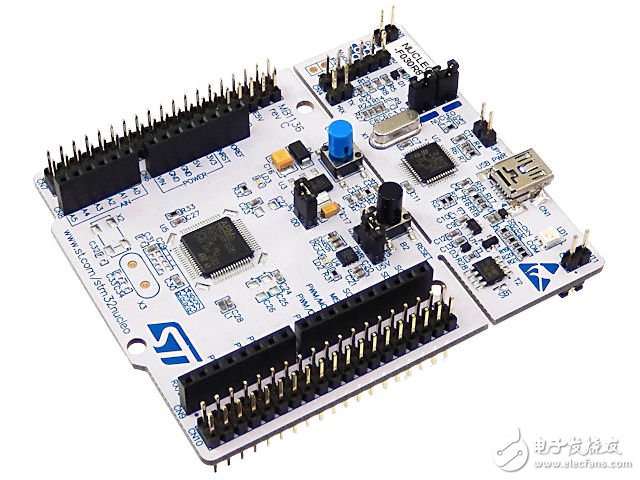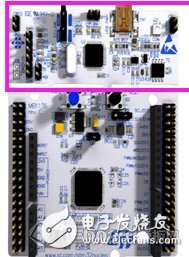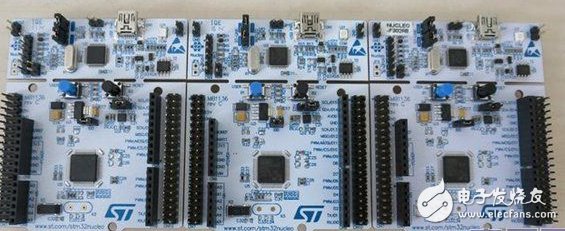The STM32 NUCLEO development platform is ST's latest low-cost platform that is easy to use and scalable. The development platform has mbed function to support Arduino interface, and also provides ST Morpho extended pin header, which can connect all peripheral peripherals of the microcontroller. It can take advantage of Arduino's huge ecosystem to facilitate fast learning and evaluation of STM32! In order to let everyone familiar with ST's versatile development platform in a short time, here is an example of the STM32-NUCLEO-072RB development board. Let's briefly introduce the features of this NUCLEO development platform.

STM32-NUCLEO-072RB development board features explain
Before explaining the features of the NUCLEO development platform, let's take a look at its predecessor, the DISCVOERY suite platform. DISCOVERY is a low-cost development kit for different MCUs introduced by ST. Different MCU models have different loading resources and appearance. The basic features are: green solder mask (green board); ST-LINK/V2 emulation External power supply with 5V or 3.3V; one reset button and one user button; the number of LED lights varies from 2 to 9; with external resources such as gyroscope, acceleration Sensor, audio decoding and segment LCD; To evaluate different MCU models, you need to buy a different DISCOVERY kit.
In order to solve the compatibility problem (evaluate multiple series of MCUs on one board), coupled with the attraction of the mature ecosystem of the Arduino development platform and the support of the mbed network programming tools, ST engineers designed such a "core". Board! Compared with DISCOVERY, it costs less because it reduces unnecessary external resources; it expands the Arduino socket so that the expansion board that "plays" with the Arduino development board can also "play" with it; it supports MBED On some office platforms that do not have permission to install, you can use the network to develop programs, and more convenient!
In general, the NUCLEO development platform consists of two parts: the ST-LINK/V2-1 emulator module and the main MCU core board module. It has six features:
1. The newly designed ST-LINK/V2-1 emulator platform can be used independently. 2. More flexible power supply mode, suitable for laboratory and on-site development and application. 3. Unified main MCU core board design. Less external resources, good scalability 5, support online and stand-alone multiple IDE development environment, rich developers' choices 6, rich software code routine support, convenient for short time to get started
Feature 1: Newly designed ST-LINK/V2-1 emulator platform
1. It is an upgraded version of the ST-LINK/V2 emulator onboard the DISCOVERY platform of the previous exploration kit. It adopts a new PCB layout and adds a STS7PF30L P-MOS transistor chip. If the USB bus is used as the power supply mode for the MCU board, you need to wait for the emulator driver to be installed before you can turn on the MOS tube to supply power to the main chip. If the PC driver is not installed, the main MCU core board cannot be powered!
2, through the SWD interface to achieve program debugging and download
3, independent jumper switch, you can use the simulation external STM32MCU development board alone! The emulator module can be separated from the main MCU core board, making it easier to use alone
4. One USB interface implements three functions: The emulator has built-in new firmware, which realizes three functions of virtual serial port, debug interface (SWD) and storage device (Mass storage).
5, TX / RX pin lead, independent USB to TTL serial line function

Feature 2: More flexible power supply

1. Universal USB bus power supply mode - controlled by signal switch
2, flexible external 5V or 3.3V or 7-12V power supply (not used in the previous exploration kit) LD1117S50TR chip to achieve 7-12V voltage input, 5V output; LD39050PU33R chip to achieve 5V input 3.3V voltage output
Feature 3: Unified main MCU core board design
1. The main MCU core board of NUCLEO development board is a unified PCB design, supporting 64-pin MCU model chips, except for MCU, the others are the same.
2, you have a NUCLEO development board, you can
Any one of STM32F030R8, STM32F072RB, STM32F103RB, STM32F302R8, STM32F334R8, STM32F401RE, STM32F411RE, STM32L053R8, STM32L152RE T6 MCU can be quickly evaluated. The code only needs to modify the pin configuration. The MCU model covers 5 large series to meet each. Industry customer needs!

Feature 4: Less external resources and good scalability
Onboard resources:
1, three LED lights
Communication indication: (LD1) User indication: (LD2) Power indication: (LD3)
2, two buttons: user button and reset button
Extended IO pin header and socket
1. With ArduinoUno Revision 3 socket, it is easy to seamlessly connect with ArduinoUno development board and its expansion board. 2. IO is led out by ST Morpho expansion pin, compatible with ST expansion board.
Let's take a look at a few expansion boards:
Arduino UNO development board
Arduino is an open source hardware platform designed by Italian engineers. It has a good ecosystem and various Shield expansion boards for special functions! Arduino UNO is the latest version of the Arduino USB interface family and serves as a reference standard template for the Arduino platform. UNO's processor core is ATmega328, with 14 digital input / output ports (6 of which can be used as PWM output), 6 analog inputs, a 16MHz crystal oscillator, a USB port, a power outlet, an ICSP header and A reset button. Input voltage (recommended) 7-12V, operating clock 16 MHz.
The kit is a low-power Bluetooth extension kit for the NUCLEO development board with UNU R3 interface compatible with Arduino and low-power, BTLE 4.0-compatible single-mode chip BlueNRG. The expansion board communicates with the MCU on the NUCLEO board via SPI. The user can change the clock frequency of the SPI. Both the SPI chip select and the SPI IRQ can be modified by the resistor on the board.
Stepper motor expansion board X-NUCLEO-IHM01A1
Stepper motor driver board based on L6474 chip, can drive up to 3 stepping motor with one NUCLEO development board

Adafruit 1.8" TFT LCD shield expansion board
Summary: With the socket interface and the dish type pin, you can make various expansion boards, such as touch buttons, TFT, SD, USB, etc.
Feature 5: Support multiple IDE development environments
The STM32 NUCLEO development board supports both online and standalone IDE platforms:
1. Support mbed (mbed.org) online IDE development environment
Inside the U disk that the emulator virtualizes, there is a web page file. If there is a network, it can be accessed after opening.
2. Support common MDK/IAR/GCC-based development environments, etc.
MDK-ARM v5.01 or higher EWARM v7.10.3 or higher TrueSTUDIO v5 or higher
Weighing sensor a kind of force sensor used on weighing apparatus. The principle of resistance strain type weighing sensor, which can convert the gravity acting on the measured object into a measurable output signal according to a certain proportion.
Module Load Cell,Weight Sensor Module,Digital Module Load Cell,Weighing Module Load Cell
Ningbo Santwell Imp & Exp Co.,Ltd , https://www.santwell.com
